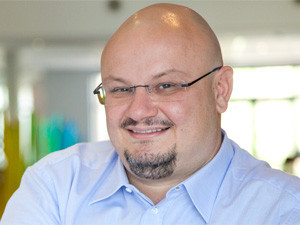
In April this year, Microsoft took a huge step along its open source path. The result was the announcement of a new, wholly owned subsidiary at its headquarters in Redmond dedicated to open technologies, called Microsoft Open Technologies. For its senior director of open source communities, it appointed ex-lawyer Gianugo Rabellini.
The technology giant already contributes to the development of key mobile device standards like HTML5, and high-profile mobile open source projects such as jQuery Mobile, Sencha Touch and Apache's PhoneGap. It is a major contributor to the Linux kernel, and many other open standards and projects.
Rabellini's path to open source technology started at an Italian high school, mostly studying things like Latin, Greek and philosophy, but developing payroll and property development software for his parents' business on the side.
Having been at a school that offered maths for two hours a week, he couldn't see himself following a career involving maths, and remembers asking himself, 'What is the university and the specialisation that will allow me to dodge mathematics?' He did three years' worth of law, passing 24 of the 26 exams needed to become a lawyer, and then decided the career was not for him.
In the six years it took to get the last two law exams done, he had far more fun programming. As a broke law student, he started running a dial-in bulletin board on Linux, a free open-source operating system, to let people discover Linux for themselves.
Diplomacy
One night, he got a message that a new university campus was being built in his town, and that the guy building its data centre needed help. Within a week, he was installing Unix machines in the university lab, with access to one of the few Internet connections in Italy at that time.
Instantly, Rabellini became an Internet and open source addict.
"I was just a hacker, and struggling with technology. The only way I could become a geek was with open source. They gave me access to source code and access to communities. I remember thinking, 'Wow! I just had a conversation with a programmer at IBM!' I would be a lawyer if it wasn't for them."
You should never ask yourself why an open source project is successful, or what the hidden agenda is.
Rabellini went on to found Europe's biggest OS consultancy, Sourcesense, and to become VP of the Apache XML Project Management Committee. He joined Microsoft's Interoperability Strategy Group in October 2010, in the same position he has now. That group became Microsoft Open Technologies in 2012. He and his team function as diplomats bringing together the many open source groups both outside and inside Microsoft.
"I am the go-to person for open source communities to talk to Microsoft, and for various Microsoft product groups to talk to open source communities. I am providing the translation layer, if you will, building on my 20 years' experience. There are many communities, and they have extremely different approaches. Not everyone goes through me, but if you want to build a new relationship, from either side to the other, I'm generally pulled in."
When most people think about 'open source', they usually don't think of large, for-profit multinational company. Why does Microsoft spend so much energy on open source?
"We have changed as a company and become more open. We listen to our customers. The ones who love Microsoft technology are being pragmatic and using other bits and pieces all over the place. Other people who prefer other technologies still also use Microsoft technology.
"Even before open source became mainstream, the biggest developer community was MSDN, the Microsoft Developer Network. Also, about four million applications run on Windows. We need to have conversations with Windows developers who love using open source building blocks. We are positive the 'either-or', Microsoft or open source, is over. It's now Microsoft and open source."
In a way, Microsoft's previously proprietary 'walled garden' now has several gates, and people and technologies easily pass in any direction. Rabellini thinks that is just part of what the overall market is doing, because 'openess' has new meanings nowadays: open source code gardens need tending.
"We've discovered that we can have tons of open source code, but if nobody is looking after it, and if no one is implementing standards, that code doesn't go anywhere.
"Today, being open means working with four pillars: open source, open standards, developer communities, and interoperability. If one of these is missing, it's not sustainable."
More participation
'Openness' will rapidly evolve towards far more participation, says Rabellini.
"I think we will see a steep rise in community development of open source code, mostly at the expense of open source as a bare licensing model. The writing is on the wall: open source without a community is not sustainable. We'll increasingly see open source development with participation of a multitude of users from different backgrounds.
"This will impact some of the open source projects in the last few years, where software was developed behind closed doors, where there is no real access from the outside and patches are not welcomed, but the developers say, 'Here's the code, under an open source licence'.
"You should never ask yourself why an open source project is successful, or what the hidden agenda is. If it is successful, it is because there are multiple participants and they all have their agendas, and that's fine. I'm seeing that openness in the cloud and in the world of devices: the way open standards, open source, interoperability and developer communities work together."
Rabellini and his team will be getting open source people from outside and inside Microsoft together to help sustain many open technologies for mobile devices, server communications and cloud computing.
First published in the December/January 2013 issue of ITWeb Brainstorm magazine.
Share